The effects of functionalized multi-walled carbon nanotube on mechanical properties of multi-walled carbon nanotube/epoxy composites
Mehdi Ardjmand1*, Meisam Omidi2, and Mohammadmehdi Choolaei3
1Chemical Engineering Department, Islamic Azad University, South Tehran Branch, Tehran, Iran
2School of Advanced Technologies in Medicine, Shahid Beheshti University of Medical sciences, Tehran, Iran
3Research Institute of Petroleum Industry (RIPI), Tehran, Iran.
Corresponding Author Email: m_arjmand@azad.ac.ir
DOI : http://dx.doi.org/10.13005/ojc/310457
Article Received on :
Article Accepted on :
Article Published : 05 Dec 2015
The mechanical properties of the multi-walled carbon nanotube (MWCNT)/epoxy composites affected by carboxyl and amino functionalized MWCNT are investigated. Tensile tests of the specimens were carried out to obtain mechanical properties of MWCNT/epoxy composites for various weight-percents (wt %) of MWCNTs. In order to properly predict the mechanical properties of MWCNT reinforced epoxy composites, the effect of MWCNTs de bonding is considered through applying a correction factor to a Halpin-Tsai equation. Applicability of the modified model was endorsed by the experimental results.
KEYWORDS:Multi-walled carbon nanotube; Halpin-Tsai equation; Debonding
Download this article as:| Copy the following to cite this article: Ardjmand M, Omidi M, Choolaei M. The effects of functionalized multi-walled carbon nanotube on mechanical properties of multi-walled carbon nanotube/epoxy composites. Orient J Chem 2015;31(4). |
| Copy the following to cite this URL: Ardjmand M, Omidi M, Choolaei M. The effects of functionalized multi-walled carbon nanotube on mechanical properties of multi-walled carbon nanotube/epoxy composites. Orient J Chem 2015;31(4). Available from: http://www.orientjchem.org/?p=13022 |
Introduction
Carbon nanotubes (CNTs) exhibit unique structural, mechanical, electrical, and thermal properties as well as their nanometer scale and high aspect ratio, which make them an ideal reinforcing agent for fabricating high strength polymer composites.
Several research groups have reported significant improvements in mechanical properties of polymeric matrices by adding a few weight percents (wt %) of CNTs [1–9]. Nevertheless, it is also found that there are some undesirable issues due to their waviness [10–13], inert , non-reactive surface [12,14,15], and highly agglomerated state [10,14], resulting from high van der Waals attraction, that may hinder the potential application of CNTs.
To overcome the obstacles mentioned above, functionalization has been suggested in various studies [15–20]. The functionalization of CNTs is an effective way, due to the fact that it does not only generate strong interfacial interactions, which improve the load transfer across the CNT-polymer matrix interface, but also induce better compatibility between CNTs and the polymer matrix. An excellent survey of the research studies on the mechanical and electrical properties of functionalized CNT-polymer composites has been recently carried out by Sahoo et al. [21].
For the typical functionalization process, functional groups such as –COOH or –OH are created on the CNTs during the oxidation using oxygen, air, concentrated sulfuric acid, nitric acid, aqueous hydrogen peroxide, and acid mixture [22,27]. In recent years, Amino-functionalization has been developed. Amino-functionalization effects the surface, interfacial, and dispersion properties of CNTs. In a study done by Ma et al. [28] mechanical properties of the CNT/epoxy composites were investigated. Garg et al. [29] reported an increase in the flexural strength of amine functionalized CNTs-reinforced epoxy composites from 55 to 140 MPa (~155% increase) at only 0.3 wt.% of CNTs.
In order to improve the precision in prediction of mechanical properties of nanocomposites, some corrections were performed by several research groups during the last decade. To take into account the agglomeration effects, a modified form of the Halpin-Tsai equation was presented by Park and Bandaru [30]. Mechanical properties of high density polyethylene composites reinforced with CNTs were presented by Kanagaraj et al. [31]. They employed both the Halpin-Tsai model and the modified form of the rule of mixture model to make a comparison between theoretical and experimental results. The effect of waviness of CNTs was considered through applying a correction factor to the modified Halpin-Tsai equation by Arasteh et al. [32]. Omidi et al. [33] modified the rule of mixture model by adopting a length efficiency parameter, orientation efficiency factor, and waviness parameter to properly predict the mechanical properties of CNT/polymer composites for both low and high wt % of CNTs.
In this paper, a possible procedure is proposed, in order to enhance the mechanical properties of polymer composites by utilizing carboxyl and amino functionalized multi-walled carbon nanotubes (MWCNTs). The effects of functionalization on the MWCNTs dispersion, wettability with polymer matrix, and the mechanical properties of MWCNT/epoxy composites were studied. It was demonstrated that surface modification has a significant effect on MWCNTs dispersion and reduction of the interfacial debonding between MWCNTs and the matrix. The mechanisms behind the improved properties of composites using functionalized MWCNTs were specifically studied. A particular emphasis was placed on applying a correction factor to the Halpin-Tsai equation, which was considered as the effect of interfacial debonding between MWCNTs and the matrix.
Experimental procedure
Materials
The MWCNTs were embedded in a commercially available thermosetting bisphenol epoxy resin containing reactive diluent, LY564/HY56, which had a low viscosity and was prepared from Ciba Geigy.
MWCNTs and their functionalized counterparts, produced by chemical vapor deposition (CVD), were purchased from Research Institute of Petroleum Industry (RIPI). The MWCNTs were characterized by an average outer wall diameter of 10-50 nm and an average length of 1-3 μm with a carbon purity of 96%.
Functionalization of MWCNTs
Ozonolysis of MWCNTs (MWCNTs-COOH)
One hundred milligrams of MWCNTs were ozonized under ozone stream at room temperature and atmosphere condition for 4 hours. The production of MWCNTs with a high content of carboxyl functional groups was achieved using hydrogen peroxide as a cleaving agent to treat the as-ozonized MWCNTs. Specifically, ozonized tubes were refluxed for 1 hour at 60°C in 36% H2O2 aqueous solution and then the mixture was stirred at room temperature for 16 hours. Subsequently, the mixture was filtered over a 0.2 μm polycarbonate membrane, washed with a large excess of methanol, and ultimately oven dried at 100ºC. Fig. 1(a) shows the Fourier transform infrared spectroscopy (FTIR) of carboxylated MWCNTs, which peaks at 1704cm-1, 1206 cm-1, and 1079 cm-1 corresponding to C=O, C-O-C asymmetric, and CO- C symmetric stretches, respectively. These peaks indicate successful generation of –COOH groups on the CNTs.
Table 1: The steady contact angles of different liquids on MWNT/ film
|
P. MWNTs |
Amino. MWNTs |
COOH. MWNTs |
|
|
LY 564 (o) |
75.3 ± 3.7 |
58.5 ± 3.1 |
64.7 ± 2.2 |
|
Water (o) |
69.2 ± 3.3 |
40.6 ± 2.4 |
51.1 ± 2.8 |
Amidation of carbon nanotubes (MWCNTs-CO-NH-R)
Twenty milligrams of the oxidized nanotubes were dispersed using sonication in 10ml of DMF and 100 milligrams of ethylenediamine. One milligram of the coupling agent HATU was added to the mixture and sonication continued for 4 hours. Then the mixture was refluxed at ~70 ºC for 2 days in N2 atmosphere. The obtained mixture was diluted with methanol and filtered through polycarbonate filter paper and then the product was washed with ethanol to remove excess amine. The product was dried in an oven at 70 ºC for 24 hours. Fig. 1 shows FTIR spectra for the prepared samples. In Fig. 1(A), spectrum of carboxylated MWCNTs, peaks at 1704, 1206, and 1079 cm-1 correspond to C=O, C–O–C asymmetric, and C–O–C symmetric stretches, respectively. These peaks indicate successful generation of –COOH groups on the nanotubes. The peak observed at 1650 cm-1 (in Fig. 1(B)) is associated with the C=O bond. It means that the C=O frequencies shifted from 1704 cm-1 in MWCNT–COOH to 1636 cm-1 in amido-functionalized MWCNTs. The existence of vibration modes corresponding to –C–N– at 1297 cm-1 and –N–H at 1507 cm-1 indicate the formation of the amide bond (Fig. 1(B)).
Preparation of the MWCNT/epoxy composite specimens
MWCNTs were initially dispersed into a hardener by tip sonication for 30 min to achieve a good dispersion. The sonication process was carried out in pulse mode and sonication power was adjusted at 60% amplitude to avoid over-heating the materials. The epoxy resin and hardener were mixed at a weight ratio of 100:30. Subsequently, the mixture was stirred with high-speed dispersant under 900 rpm for 15 min. The mixture was then cast into a metallic mold and cured at 50°C for 15 hours. The prepared composite samples were then mechanically polished to form smooth surfaces. Another thermal curing procedure for each sample was conducted at 100°C for 4 hours to achieve higher mechanical properties of the MWCNT/epoxy composites. Fig. 2a shows a typical transmission electron microscope (TEM) image of MWCNTs.
Characterization and Measurements
In this study, we have used the capillary method for measuring the surface energy of a liquid epoxy. In this method, it is possible to determine the surface energy by detecting the “capillary rise” of a liquid forming a bubble in a fine tube and drawing the bubble to fracture. Practically, in each experiment the surface energy was measured by placing a capillary tube in to a beaker containing 25 ml epoxy and measuring the liquid level which rises above the normal level in the beaker and knowing the fact that the elevation of the liquid is a function of the surface energy. It is worth mentioning that, this issue happens whenever the cohesive forces between the liquid molecules are weaker than their adhesion to the wall of the capillary tube. In order to reach reliable data, the liquid was kept in a constant temperature and all the tests were taken three times. Contact angles between the CNT films and the epoxy resin (LY564) were measured in order to investigate the changes in surface energy and wettability. In order to prepare MWCNT thin films, at first for reaching a good dispersion a solution of MWCNTs/2-propanol with a concentration of 0.2 mg/ml was dispersed for 45 min using a tip sonication. In the next step, the dispersed solution was filtered by a cellulose filter with a pore size of 0.1 µm [28]. Sessile drop method was used for measuring static contact angles between MWCNT/ films and the epoxy samples. Also, a syringe was us to make sure that each drop is squeezed on the surface carefully. After 10s, when the drop settles slowly on the MWCNT/ film, an image was taken by a camera and the image was carefully analyzed and the best-fit circle to the contact border of each drop was calculated using an image analyzing software (image analyzing 1.33). For achieving valid data, all tests were repeated five times and an average of five reading was plotted. It is observed from Young equation that the contact angle α is related to the characteristic surface energies of different interfaces among MWCNT/ film (f), epoxy matrix (m), and air (a) systems [35].

Owing to the fact that the two solid (Γf) and solid–liquid (Γfm) surface energies can be determined when two liquids with known components of surface energies were used in the contact angle measurements, we have employed water as probe liquids in this study. The solid (Γf) and solid–liquid (Γfm) surface energies are 50.7 and 22.1 mJ/m2 [28], respectively.
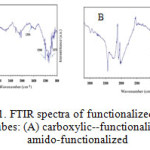 |
Figure 1: FTIR spectra of functionalized carbon nanotubes: (A) carboxylic–functionalized (B) amido-functionalized Click here to View figure |
Based on the ASTM D 638 (Type I), uniaxial tensile tests were performed at room temperature using Zwick Roel/Amsler under a crosshead speed of 1 mm/min. The dimensions of the specimens were 168 mm in length, 13 mm in width, and 5 mm in thickness. Samples without MWCNTs addition (matrix samples) were also fabricated for comparison purposes. To achieve more reliable experimental results, five samples were fabricated and tested for each wt. % of MWCNTs.
Results and Discussion
Wettability and surface energy
The results for the measured static contact angles of different probe liquids on MWCNT films are reported in Table 1. By studying the contact angle reduction, from 69.2o to 40.6o, after applying amino- functionalization instead of polar probing liquid i.e. water, it can be observed that the hydrophilicity has shown a substantial increase. The contact angle for carboxyl functionalized MWCNTs, also, showed a decrease in the amount of contact angle, from 69.2o to 51.1o, however with a less marked trend in compression with amino functionalized MWCNTs.
By using the measured contact angles and Eqs. (1) the surface energies of MWCNTs were calculated. The total surface energy of pristine, carboxyl, and amino functionalized MWCNTs measured here were 41 mJ/m2, 54 mJ/m2 and 61 mJ/m2,respectively; The reported measurements in this work are validated by their agreement with the existing experimental and theoretical results done in this field [28].
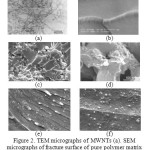 |
Figure 2: TEM micrographs of MWNTs (a). SEM micrographs of fracture surface of pure polymer matrix LY 564 (b), 0.75 wt.% P-MWNTs (c and d) and amino-MWNTs (e and f). Click here to View figure |
The interfacial interactions between MWCNTs and epoxy monomer were evaluated by measuring contact angles between the epoxy resin and the MWCNT films. As table 1 presents, after functionalizing MWCNTs with carboxyl groups contact angle decreases from 75.3o to 64.7o, this decline has also been observed after amino-functionalization but with a greater decrease, reaching to 58.5o. This difference results from the enhanced wettability between the MWCNTs and epoxy.
At first, it was necessary to measure the surface energy (Γm) of epoxy LY 564, in order to calculate the interfacial energie of MWCNT/epoxy interface (Γfm). The experiments demonstrated Γm = 58.34 ± 0.5 for epoxy LY 564. Surface energies (Γm) obtained for carboxyl, and amino functionalized MWCNT were 25.9, 28.4 and 33.1 mJ/m2, respectively, which illustrates the positive effect of functionalization in improving the interfacial interactions between MWCNTs and polymer matrix.
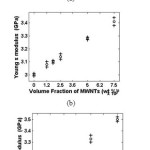 |
Figure 3: Young’ modulus response of the MWNT/epoxy composites vs. CNT weight percentage; (a) pristine MWNT, (b) carboxyl- MWNT, (c) and amino-MWNT. Click here to View figure |
Morphology of tested MWCNT/epoxy composites
Scanning electron microscopy (SEM) was employed to observe the fracture surface of the samples after tensile test. Fig. 2b shows SEM micrographs of fractured surface of the pristine epoxy LY 564.
Studying the SEM images, fig. 2(c-e), made it possible to examine the fracture surfaces of fully cured composites, in order to compare the dispersion states of MWCNTs. The sample containing P-MWCNTs presented clear CNT agglomerations (fig. 2c). However, samples containing amino-MWCNTs did not demonstrate such agglomerations (fig. 2d). From the previous results, it can be concluded that (i) the functionalization had a considerable effect on improving the dispersion of MWCNTs and (ii) even after fully curing the epoxy resin the enhanced dispersion of MWCNTs remained stable. In addition, studying the SEM images (fig. 2f) proved long MWCNT pull outs, and indicated the presence of voids on the fractured surfaces of the composites containing P-MWCNTs. The mentioned results suggest weak adhesion in the P-MWCNT–matrix. However, complete opposite results were observed in the case of functionalized MWCNTs, which can be due to the covalent interactions in the functionalized MWCNTs matrix that has caused strong adhesion.
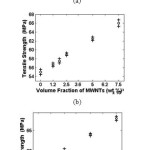 |
Figure 4: Tensile strength response of the MWNT/epoxy composites vs. MWNT weight percentage; (a) pristine MWNT, (b) carboxyl- MWNT, (c) and amino-MWNT. Click here to View figure |
Mechanical properties of the tested composites
The mechanical performance of a MWCNT /polymer composite depends on the dispersion of MWCNTs and interfacial interaction between MWCNTs and polymer. Mechanical properties of MWCNT/epoxy composite specimens made of LY564 polymers reinforced with 0.12, 0.18, 0.25, 0.50 and 0.75 wt. % of pristine and functionalized MWCNTs are plotted in Figs. 3 and 4, where the average values of five samples are taken into account for each composition. The Young‘s modulus of each material is calculated as the average of the slope of the stress–strain curve in the linear region (<2% strain).
Increasing MWCNTs in the composites containing P-MWCNTs resulted in a rapid growth in the Young‘s modulus of these composites. Composites containing functionalized MWCNTs (both carboxyl- MWCNTs and amino- MWCNTs) at the same MWCNT content, also presented a significant increase in the Young‘s modulus, but with a more pronounced growth. Moreover, the tensile strength of composites containing functionalized MWCNTs presented higher amounts than P-MWCNT counterparts. The previous results could be because of the combination of better MWCNT dispersion and stronger filler–matrix adhesion resulting from the functionalization. Farther experiments indicated that in composites containing P-MWCNTs the Young‘s modulus and tensile strength degraded above 0. 5 wt.% of MWCNT contents, while the strength of composites containing carboxyl-MWCNTs and amino-MWCNTs showed a 0.23% enhancement, resulting from the improved interfacial interactions between the functionalized MWCNTs and the matrix.
Between carboxyl-MWCNTs and amino-MWCNTs, composites containing amino-MWCNTs presented a greater enhancement in the Young‘s modulus and tensile strength. This difference was true, up to the MWCNT content of 0.75 wt.% MWCNTs. According to the mentioned observations, it can be concluded that amino-MWCNTs have a more decisive effect on improving mechanical properties of composites in comparison with carboxyl-MWCNTs, especially at high MWCNT contents.
The first reason of the enhancement in mechanical properties of MWCNTs/epoxy composites could be the interfacial reactions which take place between the MWCNT surface and epoxy resin. The oxygen groups on the surface of carboxyl-MWCNTs create hydrogen-bridge bonds with the epoxy upon oxirane opening. Although, covalent bonds are stronger than hydrogen bonds, these hydrogen bonds have a significant positive effect on increasing the interactions between the MWCNTs and polymer matrix, resulting in a great improvement in the mechanical properties of a composite. On the other hand, in amino–MWCNTs there are nitrogen-contained functional groups (both primary and secondary amines) which react with the epoxide groups of the epoxy resin and increase the viscosity of the system with starting the ring-opening reactions followed by cross-linking reactions [36]. As a result, the strong interfacial adhesion facilitates the efficient load transfer between the matrix and MWCNTs, resulting in a considerable improvement in the mechanical properties.
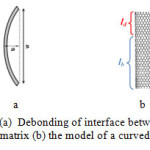 |
Figure 5: (a) Debonding of interface between a CNT and matrix (b) the model of a curved CNT Click here to View figure |
Characterization and modeling of the mechanical properties of functionalized MWCNT/epoxy composites
The dependence of mechanical properties of polymer-based composites on the CNT volume fraction, shape factor, and waviness correction factor can be estimated by modified micromechanical techniques, including Halpin-Tsai method [31] and modified series model [32]. An equation which is often used for modeling the mechanical behavior of reinforced composites is the Halpin-Tsai equation as given in equation (2).

In which C = 2(l/d) is a constant shape factor related to the aspect ratio of reinforcement length l and diameter d, and α is the orientation factor which has been founded by Later on Cox [37]. For the random orientations in two dimensions α =1/3, and for the random orientations in three dimensions α =1/6; EM ,ENT , and VNT are the modulus of the matrix, modulus of the fiber, and volume fraction of the fiber, respectively. In addition, Kw is the waviness correction factor, which can be expressed as [31]:
Kw = 1-a/w (3)
In which a is the amplitude and w is the half-wavelength of a curved CNT (Fig. 5a).
According to the experimental results reported in the literature, in addition to the above parameters, the interfacial debonding between CNT and the matrix is another important parameter that influences the reinforcing efficiency. It can be seen that a fully debonded CNT does not carry any load; they simply play the role of voids. To take into account the debonding effects, the modified Halpin-Tsai equation is presented as below. It is necessary to note, the influence has not been much quantitatively discussed in the literature.
A representative volume (V) of a composite, contains N CNTs with the length of l. As shown in Fig. 5b the perfectly-bonded and the fully debonded CNT length are lb, and ld, respectively.The CNT aspect ratio C and the CNT volume fraction VNT can be written as:
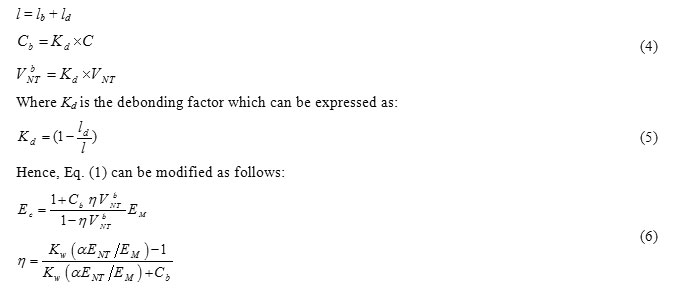
It is necessary to emphasize that for modeling the tensile strength of composites, equations similar to 2-6 can be written.
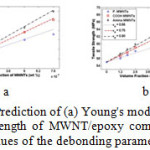 |
Figure 6: Prediction of (a) Young’s modulu and (b) Tensile strength of MWNT/epoxy composites for various values of the debonding parameters with Kw = 0.4. Click here to View figure |
Prediction of the mechanical properties
In this subsection, a prediction of mechanical properties of MWCNT/epoxy composites is made using the modified Halpin-Tsai equation, presented in the previous section. The present analytical predictions were made for different values of the debonding parameter (Kd) with ENT = 1000 GPa, α =1/6, and EM =3.00 GPa. The data given in Figs. 6a and 6b show that the current predictions of mechanical properties of MWCNT/epoxy composite are in excellent agreement with the experimental data.
A TEM image of MWCNTs (Figure 2a) illustrates that waviness of the MWCNTs is rather high. The waviness factor, Kw, was obtained through geometrical analysis of the TEM micrographs, as depicted in Figure 2a. It should be noted that Kw was calculated from a statistical approach. To calculate Kw, a and w should be measured first. After a random selection of a certain number of carbon nanotubes in a TEM image, a and w were measured precisely by image processing. Using the average values of a/w, Kw was calculated from Equation (6). According to the analyzed data, Kw is estimated to be 0.4.
As shown in Figs. 6a and 6b, the best fit of the Young’s modulus (Ec) and tensile strength (Sc) to the MWCNT volume fraction indicated a value of Kd = 0.75 for the carboxyl functionalized MWCNT based composites, whereas Kd was calculated to be 0.55 for pristine MWCNT polymer composites. On the other hand, a fit for amino functionalized MWCNT based composites was obtained with Kd = 0.9, which implies that debonding effects were further reduced in these materials. These values completely agreed with theoretical predictions. As mentioned before, covalent bonds between amino functionalized MWCNTs and epoxy groups of polymer could be responsible for the diminished deboning effects; however for carboxyl functionalized MWCNTs, hydrogen bonds are responsible for this issue.
In addition,the results coming out from equation (6) have been compared with an experimental data available in the literature for composites containing MWCNT fillers. In Fig. 7, an interesting comparison is made for maleic anhydride (MA) functionalized MWCNT- Epon828 composites [34]. As shown in Fig. 7(b), the waviness parameter, Kw,can be estimated as 0.5.
![Figure 7. (a) Prediction of Tensile strength of MWCNT/epoxy composites for various values of the debonding parameters with [34] (b) SEM image of well dispersed MWCNTs in a polymer matrix [34].](http://www.orientjchem.org/wp-content/uploads/2015/12/Vol31_No4_The_Meh_Fig7-150x150.jpg) |
Figure 7: (a) Prediction of Tensile strength of MWCNT/epoxy composites for various values of the debonding parameters with [34] (b) SEM image of well dispersed MWCNTs in a polymer matrix [34]. Click here to View figure |
It can be deduced from Fig. 7(a) that our predictions are almost coincident with Tseng et al. results [34] when the debonding parameter, Kd, is equal to 0.55 for pristine and 0.90 for MA functionalized MWCNT /epoxy composites.
Conclusions
The effects of MWCNTs functionalization on the dispersion, surface energy, wettability and mechanical properties of MWCNT/epoxy nanocomposites are investigated. It is demonstrated that surface modification significantly enhanced hydrophilicity and wettability of MWCNTs with epoxy resin. It is found that functionalization treatment also improve MWCNTs dispersion and reduction of the interfacial debonding between MWCNTs and the matrix, resulting in enhanced mechanical properties of MWCNT/epoxy composites compared to those containing pristine MWCNTs. It shows that strong correlation exists between the functionalization, dispersion and wettability of MWCNTs and the mechanical properties of MWCNT/epoxy composites and functionalized MWCNTs is a promising reinforcement for the epoxy materials.
Since the interfacial debonding between MWCNTs and the matrix is effective parameter in mechanical properties of MWCNT/epoxy composites, a Halpin-Tsai equation was modified using the debonding correction factor (Kd). The present modified model can be easily used to predict the Young‘s modulus and tensile strength of the tested composites. Furthermore, a few comparative studies were performed with literature data to demonstrate the validity and accuracy of the proposed prediction model.
Acknowledgement
This paper extracted from the research project entitled “Improvements and Optimization of Mechanical Characteristic of High Performance Cylindrical Carbon Fiber Epoxy Composites by Using Carbon Nano Structure” which was supported by Islamic Azad University, South Tehran Branch, Tehran, Iran.
Reference
- Rokni, H.; Milani, A. S.; Seethaler, R. J.; Omidi, M. Int. J. Compos. Mater. 2013, 3(A), 45-57
- Rashidi, A.; Omidi, M.; Choolaei, M.; Nazarzadeh, M.; Yadegari, A.; Haghierosadat, F.; Oroojalian, F.; Azhdari, M. Adv. Mater. Res. 2013, 705, 332-336
- Omidi, M.; Alaie, S.; Rousta, A. Meccanica, 2012, 47(4), 817-833
- Xie, N.; Jiao, Q. J.; Zang, C. G.; Wang, C. L.; Liu, Y. Y. Mater Des 2010, 31(4), 1676-1683
- Yeh, M.; Tai, N.; Liu, J. Carbon 2006, 44(1), 1-9
- Zhang, X.; Liu, T.; Sreekumar, T. V.; Kumar, S.; Moore, V. C.; Hauge, R. H.; et al. Nano. Lett. 2003, 3(9), 1285-1288
- Eitan, F. T.; Fisher, R.; Andrews, L. C.; Brinson, L.; Schadler, S. Compos. Sci. Technol. 2006, 66(9), 1162-1173
- Etika, K. C.; Cox, M. A.; Grunlan, J. C. Polymer 2010, 51(8), 1761-1770
- Zheng, M.; Jagota, A.; Semke, E. D.; Diner, B. A.; Mclean, R. S.; Lustig, S. R.; Richardson, R. E.; Tassi, N. G. Nat. Mater. 2003, 2(5), 338-342
- Qian, D.; Dickey, E.C.; Andrews, R.; Rantell, T. Appl. Phys. Lett. 2000, 76(20), 2868-2870
- Lau, K. T.; Lu, M.; Liao. K. Composites A 2006, 37(10), 1837-1840
- Andrews, R.; Weisenberger, M. C. Curr. Opin. Solid. State. Mater. Sci. 2004, 8(1), 31-37
- Shaffer, M. S. P.; Windle, A. H. Adv. Mater. 1999, 11(11), 937-941
- Ning, J. W.; Zhang, J. J.; Pan, Y. B.; Guo, J. K. Mater. Sci. Eng. A. 2003, 357(1), 392-396
- Shi, D. L.; Feng, X. Q.; Huang, Y. G. Y.; Hwang, K. C.; Gao, H. J. J. Eng. Mater. Tech. 2004, 126(3), 250-257
- Auad, M. L.; Mosiewicki, M. A.; Uzunpinar, C.; Williams, R. J.J . Poly.Eng. Sci. 2010, 50(1), 183-190
- Cividanes, S.; Brunelli, L.; Antunes, D. D.; Corat, E. F.; Sakane, E. J.; Thim, G. P. J.Appl. Poly. Sci. 2012 , 127(1), 544-553
- Damian, C. M.; Pandele, A. M.; Andronescu, C.; Ghebaur, A.; Garea S. A.; Iovu, H. Fuller. Nanotub. Car. N. 2011, 19(3), 197-209
- Ling, F.; Gang, L.; Gang, S.; Xiao, Y. Adv. Mat. Res. 2009, 553, 79-82
- González-Domínguez, J. M.; Díez-Pascual, A. M.; Ansón-Casaos, A.; Gómez-Fatou, M. A.; Martínez, M. T. J. Mat. Chem. 2011, 21(38), 14948-14958.
- Sahoo, N. G.; Rana, S.; Cho, J. W.; Li, L.; Chan, S. H. Pro. Poly. Sci. 2010, 35(7), 837-867.
- Liu, J.; Rinzler, A.; Dai, H.; Hafner, J.; Bradley, R., Boul, P.; et al. Fullerene pipes. Science 1998, 280, 1253–1256
- Mawhinney, D.; Naumenko, V.; Kuznetsova, A.; Yates, J.; Liu, J.; Smalley, RE. Chem. Phys. Lett. 2000, 324, 213–216
- Hu, H.; Bhowmik, P.; Zhao, B.; Hamon, M.; Itkis, M.; Haddon, C. Chem. Phys. Lett. 2001, 345, 25–28
- Hemon, M.; Chen, J.; Hu, H.; Chen, Y.; Itkis, M.; Rao, A.; et al. Adv. Mater. 1999, 11, 834–840
- Chen, J.; Hamon, M.; Hu, H.; Chen, Y.; Rao, A.; Eklund, P.; et al. Sci. 1998, 282, 95–98
- Bandow, S; Rao, A.; Williams, K.; Thess, A.; Smalley, R.; Eklund, P. J. Phys. Chem. B 1997, 101, 8839–8842
- Peng-Cheng, M; Shan-Yin, M.; Ben-Zhong, T.; Jang-Kyo, K. Carbon 2010, 48, 1824-1834
- Parveen, G.; Bhanu, P.; Gaurav, K.; Tejendra, G.; Indresh, P.; Seth, R. K.; Tandon, R. P.; Rakesh, B. J. Poly. Res. 2011, 18, 1397–1407
- Park, S.H.; Bandaru, P.R. Polymer 2010, 51, 5071-5078.
- Kanagaraj, S.; Varanda, R. F.; Zhil’tsova, V. T.; Oliveira, A. S. M.; Simoes, O. A. J. Comp. Sci. Tech. 2007, 67(15), 3071-3077
- Arasteh, R.; Omidi, M.; Rousta, A. H. A.; Kazerooni, H. J. Macromol. Sci. Phy. 2011, 50(12), 2464-2480
- Omidi, M.; Rokni Damavandi Taher , H.; Milani, A. S.; Seethaler, R. J.; Arasteh, R. Carbon 2010, 48 (11), 3218-3228
- Tseng, C.; Wang, C.; Chen, C. Y. Chem. Mat. 2007, 19(2), 308-315.
- Chawla, K.K. Composite Materials, Science and Engineering, Spring- Verlag, New York, (1987)
- May, CA. Epoxy resins: chemistry and technology. 2nd ed. New York: Marcel Dekker Inc.; 1988
- Cox, H.L. Brit. J. Appl. Phys. 1952, 3, 72–79

This work is licensed under a Creative Commons Attribution 4.0 International License.









